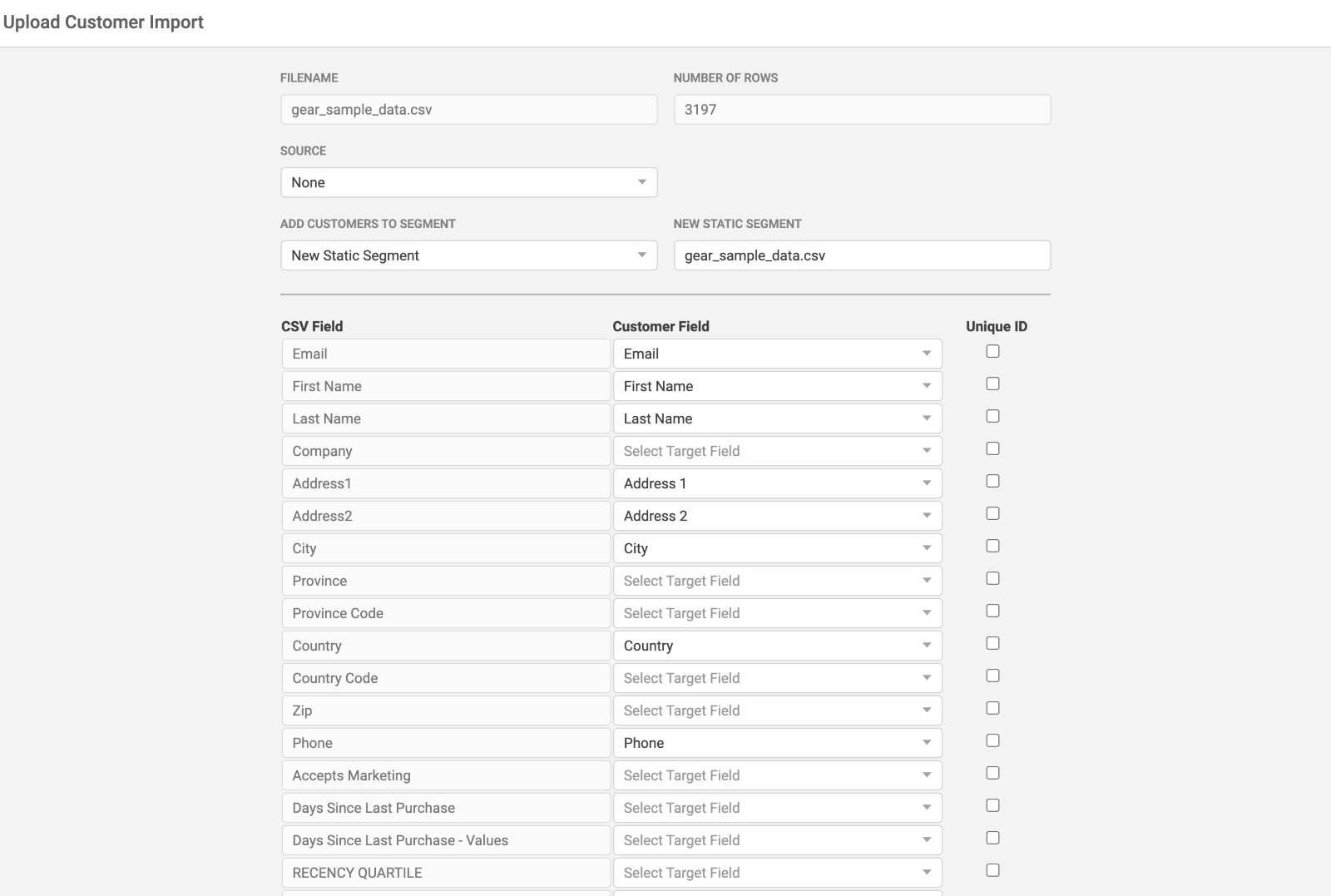Cinch provides methods for customers to import their customers directly from their servers, mostly through the Integrations. Cinch also allows our users to import spreadsheet documents to input customer information directly into your customer database in Cinch. The only spreadsheet file type we currently accept are .csv files.
These spreadsheet documents are, outside of the Integrations pages the best way to directly add data to your customers pages. Let’s dive right in to how you can upload your data into Cinch, and then make sure it can become part of your marketing campaigns instantly. 
Above you can see a clean and untouched Customer Import Menu. Don’t worry, it won’t be empty long. You’ll see that we only have one button for you to press to go forward. Go ahead, let’s press Upload. We can search through the results of your uploading later, once we have something to search through.

This will be the screen you see when you select Upload. There are two methods of importing your files. The first is to simply drag and drop a file into the square, which will prompt the upload. The other option is to select the ‘Browse Files’ and from your computer select the file you wish to upload. As a reminder, the only spreadsheet document type that we accept are CSV files.

Now, you’ll get a view of this screen after the file is uploading. Pay attention to It, as this is the stage where our software will try to detect and determine if your file has any problems or cells of your spreadsheet cannot be interpreted. If your spreadsheet file will have an error, this is where our patented software will catch them. The most common reasons that an error might occur, or your CSV file might fail to upload would be as follows:
- Characters are not recognizable. Sometimes a unique character might make its way into a cell of a spreadsheet document.
- The contents of a cell are larger than 255 characters. This is the character limit for any single entity that can be processed.
- The CSV file is larger than 10 million rows. Too large of a CSV file will cause the process to take too long or use extreme amounts of Cinch’s system resources.
- Data Type mis formatting. Please make sure that your data fields are formatted correctly before uploading.

The top of this page will list the name of the file that you uploaded, as well as the number of rows that will be inserted into your company page on Cinch. Every single row will be a customer, or an update to an existing customer. When you list the source, you can select or create a selection that reflects where this CSV file was generated. To create a selection, just choose ‘Other’. Every time you upload a CSV file after this, that selection will be available.
One of Cinch’s most celebrated features are its ability to use segments. This file upload has the ability to select a segment for the newly created rows of the CSV Import to be added to. You may select from the two menus in regards to adding these customers to a static segment you have already created or a new static segment. That way the moment these customers are added to Cinch, you can have them added to your already existing segments. In this manner you can instantly and painless add the contents of a CSV file to a static segment or New Customer node within Journeys.
If your import does not complete, please contact support. The larger the CSV Import, the longer this process will take. In the above screenshot you will see what will happen once your import is successful. Each of the columns in your spreadsheet document will be listed on the left. The top entity, or a header for each column will be listed as the CSV field. Or rather, this will be what our software interprets to be what you have named each column.
The right columns under ‘Customer Field’ represent the data types that Cinch accepts. Each has a dropdown menu that will allow you to navigate each of the columns you have in your upload to a data type that Cinch recognizes. Selecting any one of these fields as the ‘Unique ID’ will mark that field as a preferred identifier. Any existing customer that is affected by this upload will have their information updated and replaced, if this matches. Normally, Cinch does not replace information that stacks or is duplicated. When a customer you already have in your company information is also in the CSV file you are uploading, this does not replace their name, email, or address unless the unique ID is flagged to do so. The most that our system will do in the case of a duplicate ID is add ‘empty’ fields to the existing record. It will not update unless you mark an import with Unique ID.
Once you select and finalize this upload, you will be taken back to the Imports Menu. It will list a new item in its menu, with one of three statuses. Success will be the status of all completed uploads. Error will be the status if something has gone wrong, which while we do not expect we are prepared to assist. Please contact support in this case, and we will assist in finding out what may have gone wrong. The last status is Processing, which is what you should see once you begin the upload. This represents your CSV file being added to your company, and may take up to a day in the largest cases. You may has as many CSV files as you need processing at the same time. It will not change the upload speed to have five or fifty CSV files being uploaded at once.
At any time you may delete a CSV import, but this will remove its customers that were uploaded to your company.
